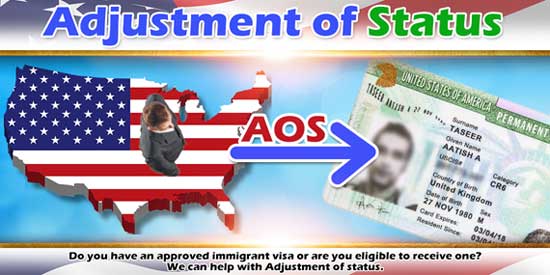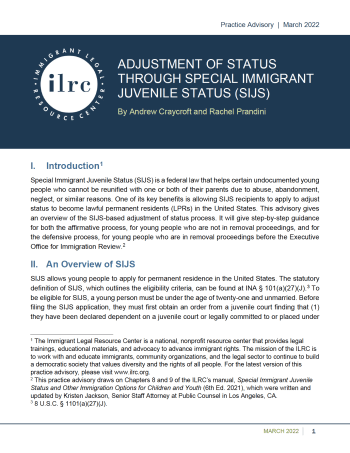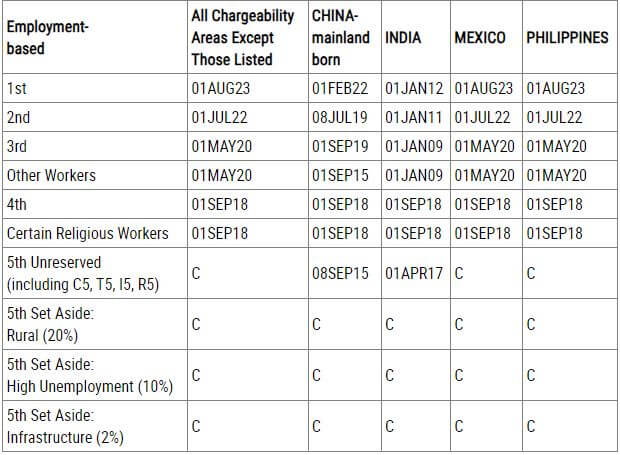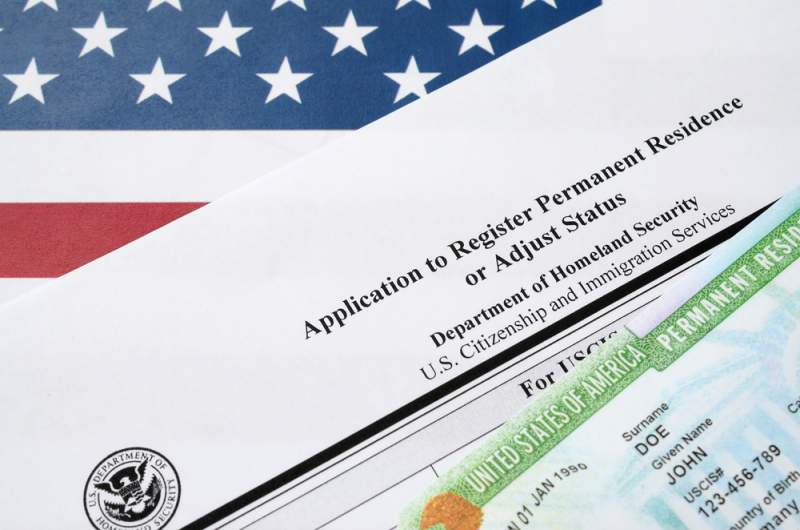Table of Contents
When it comes to seeking permanent residency in the United States through the adjustment of status process, understanding the concept of the priority date is crucial. The priority date plays a pivotal role in determining when an applicant can move forward with their green card application. In this article, we will delve into the significance of the priority date and how it impacts adjustment of status proceedings.
Navigating the adjustment of status process for permanent residency in the United States requires a comprehensive understanding of the priority date, a critical element that shapes the timeline and progress of your green card application. Here, we explore the significance of the priority date and its far-reaching impact on the adjustment of status proceedings:
Foundation of the Visa Bulletin: The priority date serves as the foundation for the Visa Bulletin, a monthly publication by the U.S. Department of State. The Visa Bulletin provides essential information regarding the availability of immigrant visas (green cards) based on various visa categories and countries of chargeability.
Family or Employment-Based Categories: The priority date is particularly significant in the context of family-sponsored and employment-based visa categories. Each applicant is assigned a priority date based on their family relationship or employment preference category, which determines their place in the green card queue.
Queue Management: Due to numerical limitations on the allocation of green cards each fiscal year, a backlog can develop in certain visa categories. The priority date establishes an applicant’s place in the queue and progression toward green card eligibility depends on when their priority date becomes current.
Waiting Periods: The time between filing an immigrant petition (such as Form I-130 or Form I-140) and the priority date becoming current can vary significantly. For some individuals, this waiting period can be relatively short, while for others, it may extend over several years.
Country of Chargeability: The priority date also takes into account the applicant’s country of chargeability, which is typically their country of birth. The Visa Bulletin may distinguish between chargeability areas, meaning that applicants from countries with high demand for green cards may face longer waiting periods.
Immediate Relatives vs. Preference Categories: Immediate relatives of U.S. citizens, such as spouses, parents and unmarried children under 21, are not subject to numerical limitations and do not require a priority date to become current. They can typically proceed with their green card applications without waiting for visa availability.
Employment Preference Categories: Employment-based green card applicants are divided into preference categories, ranging from EB-1 to EB-5. The availability of green cards within these categories depends on the priority date, with higher preference categories generally having more favorable visa availability.
Adjustment of Status Timing: Understanding your priority date is crucial for determining the appropriate time to file your Form I-485 (Application to Register Permanent Residence or Adjust Status). Filing too early can result in a rejection or delay, while filing too late can lead to missed opportunities.
Visa Retrogression: Occasionally, the Visa Bulletin may retrogress the priority dates for certain visa categories, meaning that they move backward in time. This can happen due to high demand or limitations on visa numbers. Applicants must be aware of potential retrogression and adjust their plans accordingly.
Consistency in Documentation: Consistency in maintaining accurate and up-to-date documentation related to your priority date, such as immigrant petitions and visa bulletins, is essential. Errors or discrepancies can lead to complications in your green card application process.
In conclusion, the priority date is a pivotal component of the adjustment of status process for obtaining permanent residency in the United States. It determines your place in the green card queue, influences your waiting period and plays a vital role in the timing of your application. Staying informed about your priority date’s progression and adhering to the Visa Bulletin is crucial for successfully navigating the adjustment of status proceedings.
To expand your knowledge on this subject, make sure to read on at this location: PCT Applicant’s Guide Introduction to the National Phase – Valid as …
What Is a Priority Date?
A priority date is a key component of the U.S. immigration system, primarily used in family-sponsored and employment-based visa categories. It is the date when a qualifying petition or application is properly filed with U.S. Citizenship and Immigration Services (USCIS) or with a U.S. consulate or embassy abroad. The priority date establishes a person’s place in the queue for visa processing, particularly in cases where visa numbers are subject to annual quotas.
Understanding the concept of a priority date is essential when navigating the complex U.S. immigration system. This date plays a crucial role in determining an individual’s eligibility and place in the queue for visa processing. Here’s an extended explanation of the significance of a priority date:
1. Family-Sponsored and Employment-Based Categories: Priority dates are primarily used in family-sponsored and employment-based visa categories. In these immigration pathways, the number of available visas is often limited and the priority date helps establish a fair and organized system for allocating them.
2. Filing of Petitions and Applications: The priority date is set when a qualifying petition or application is properly filed with the relevant immigration authority, which can be either U.S. Citizenship and Immigration Services (USCIS) for individuals in the United States or a U.S. consulate or embassy abroad for those applying from overseas.
3. Establishing the Queue: Once the priority date is established, it essentially marks the individual’s place in the visa processing queue. This queue operates on a first-come, first-served basis, with earlier priority dates receiving priority in visa allocation.
4. Annual Visa Quotas: In many visa categories, annual quotas exist, limiting the number of visas that can be issued each fiscal year. The priority date determines an applicant’s eligibility for visa allocation based on whether their priority date falls within the available visa numbers for that particular year.
5. Waiting for Visa Bulletin Updates: Visa numbers are allocated based on the preference category and the country of origin of the applicant. The Visa Bulletin, published monthly by the U.S. Department of State, provides information on visa availability, which is critical for applicants to track their progress in the queue.
6. Advancing in the Queue: Over time, as the Visa Bulletin advances, individuals with earlier priority dates become eligible for visa processing and can proceed with their immigration journey. The priority date acts as a reference point for determining when an applicant can move forward in the process.
7. Retrogression: In some cases, due to high demand, visa numbers can retrogress, meaning that the priority dates required for visa processing may move backward rather than forward. This can result in delays for applicants and underscores the importance of monitoring the Visa Bulletin.
8. Retention of Priority Date: In certain situations, a priority date can be retained and transferred to a different family-sponsored or employment-based visa category if the circumstances change. This provision allows individuals to preserve their place in the queue if their initial category becomes oversubscribed.
9. Impact on Waiting Times: The priority date has a direct impact on the waiting time for visa processing. Individuals with earlier priority dates typically have shorter waiting times, while those with later priority dates may face longer delays, particularly in categories with high demand.
In conclusion, a priority date serves as a pivotal reference point in the U.S. immigration system, particularly in visa categories subject to annual quotas. It helps establish a fair and orderly process for allocating visas, ensuring that individuals with earlier priority dates have priority in the visa queue. Staying informed about the Visa Bulletin and understanding the significance of your priority date is crucial when pursuing family-sponsored or employment-based immigration to the United States.
You can also read more about this here: Adjustment of Status Filing Charts from the Visa Bulletin | USCIS

Understanding Visa Categories
To grasp the importance of the priority date, it’s essential to understand the visa categories and the visa bulletin:
To truly appreciate the significance of the priority date, one must delve into the intricate world of U.S. immigration and understand the pivotal role it plays in the allocation of immigrant visas. This understanding hinges on a grasp of both the visa categories and the visa bulletin:
Visa Categories as Pathways to the U.S.: Visas are not one-size-fits-all; rather, they are divided into various categories, each serving a specific purpose. These categories determine who is eligible to apply for a visa and under what circumstances. Common categories include family-sponsored visas, employment-based visas, diversity visas and humanitarian visas like refugee or asylee status. Each category has its own set of eligibility requirements and allocation of visa numbers.
The Visa Bulletin as the Gatekeeper: The visa bulletin is a monthly publication issued by the U.S. Department of State that provides valuable information about the availability of immigrant visa numbers. It separates the world into regions and countries, each with its allocation of visas and is divided into family-sponsored and employment-based preference categories. The visa bulletin plays a critical role in managing the demand for immigrant visas.
Now, let’s explore the implications of understanding these concepts:
Managing Visa Demand: The visa bulletin serves as a tool to manage the allocation of visas, preventing any single category or country from monopolizing the available slots. By tracking the visa bulletin, applicants can gauge when they may become eligible to apply for a visa based on their priority date and visa category.
Waiting Periods and Priority Dates: In many visa categories, the demand for visas far exceeds the supply. This leads to waiting periods, during which applicants must monitor their priority date. Your priority date is essentially your place in line for visa processing. It is established when USCIS receives your initial petition or application. Once your priority date becomes current according to the visa bulletin, you can move forward in the visa application process.
Preference Categories and Priority Dates: Different visa categories have different preference levels (e.g., family-sponsored preferences F1, F2A, F2B, F3 and F4 or employment-based preferences EB1, EB2, EB3 and EB4). The priority date’s significance lies in determining your place within these preference categories. Applicants with earlier priority dates have higher priority in visa allocation, while those with later dates must wait until their date becomes current.
Strategy and Planning: Understanding the visa bulletin and the priority date system is crucial for strategic planning. It allows applicants to anticipate waiting times, make informed decisions regarding their immigration journey and explore alternative pathways if their desired category has lengthy waiting periods.
Timing Matters: For some individuals, achieving a current priority date may take several years, while for others, it may happen relatively quickly. This timing can significantly impact family reunification, career opportunities and personal plans.
Legal Representation: Given the complexity and potential variations in the visa bulletin, it’s often advisable to seek legal representation, especially for employment-based categories where timing can be critical. An experienced immigration attorney can help you navigate the system, optimize your chances of success and ensure that your application remains current.
In summary, understanding the priority date system and its relationship with visa categories and the visa bulletin is essential for anyone navigating the U.S. immigration process. It influences when you can proceed with your immigration application, impacts your overall waiting period and plays a pivotal role in family reunification and career opportunities. Staying informed and potentially seeking legal guidance can help you make the most of this critical aspect of the immigration journey.
For additional details, consider exploring the related content available here The Visa Bulletin

Family-Sponsored Categories
For family-sponsored visa categories, the U.S. government sets annual limits on the number of visas issued in each category. These categories include:
For family-sponsored visa categories, the U.S. government establishes annual limits on the number of visas issued in each category, reflecting the country’s immigration policies and priorities. These family-based immigration categories serve as a means for U.S. citizens and lawful permanent residents to reunite with their close family members. It’s essential to understand these categories and the numerical limitations they entail, as they play a pivotal role in determining the timing and feasibility of family reunification. Here, we’ll explore the various family-sponsored visa categories subject to annual numerical caps:
1. F1 – Unmarried Sons and Daughters of U.S. Citizens: This category is for unmarried sons and daughters (21 years or older) of U.S. citizens. The annual limit is placed on the number of visas available for this group.
2. F2A – Spouses and Children of Permanent Residents: F2A visas are designated for spouses and minor children (under 21) of lawful permanent residents (green card holders). Like other categories, there are numerical limitations to control the number of visas granted each year.
3. F2B – Unmarried Sons and Daughters (21 years or older) of Permanent Residents: Unmarried sons and daughters of green card holders who are 21 years or older fall under this category and there’s a numerical cap for visas.
4. F3 – Married Sons and Daughters of U.S. Citizens: This category encompasses married sons and daughters of U.S. citizens and like the others, it operates under a yearly quota.
5. F4 – Siblings of Adult U.S. Citizens: The F4 category includes siblings of adult U.S. citizens. It’s worth noting that this category typically has a longer waiting period due to high demand and limited visa numbers.
Understanding these family-sponsored visa categories is essential for those who wish to bring their loved ones to the United States. Here are some additional insights into the numerical limitations and implications:
– Visa Bulletin: To keep applicants informed about visa availability, the U.S. Department of State publishes a monthly Visa Bulletin. This bulletin outlines the current visa cutoff dates for each category, indicating whether visa numbers are available or if there’s a waiting period.
– Priority Dates: When the demand for visas in a particular category exceeds the annual limit, applicants are assigned a priority date based on their filing date. They must wait until their priority date becomes current before proceeding with their visa applications.
– Quota Backlogs: Due to high demand in some family-sponsored categories, applicants may encounter significant waiting periods, known as visa quota backlogs. These delays can impact family reunification plans and the timing of immigration.
– Exceptions: Certain family members, such as immediate relatives of U.S. citizens (spouses, parents and unmarried children under 21), are not subject to numerical caps. This means there is no limit to the number of visas issued for these categories, making them faster paths to reunification.
In conclusion, understanding the family-sponsored visa categories and their annual numerical limits is crucial for anyone seeking to bring their family members to the United States. The numerical caps are intended to manage immigration flow and they often result in waiting periods for certain categories. It’s essential to monitor the Visa Bulletin, keep track of priority dates and seek legal counsel to navigate the family-sponsored immigration process effectively and reunite with your loved ones in a timely manner.
Don’t stop here; you can continue your exploration by following this link for more details: Visa Availability and Priority Dates | USCIS

F4: Siblings of Adult U.S. Citizens
The priority date is critical in these categories because it determines an applicant’s place in the waiting line. Visa numbers become available based on the applicant’s relationship to the U.S. citizen or permanent resident petitioner and the respective visa category.
Certainly, let’s delve deeper into why the priority date is critical in family-sponsored and employment-based visa categories:
1. Managing Visa Number Allocation:
The priority date serves as a fundamental tool for the U.S. government to manage the allocation of available visa numbers effectively. Here’s how it plays a crucial role:
Limited Visa Quotas: Family-sponsored and employment-based visa categories each have their annual quotas. These quotas cap the number of visas that can be issued in a given fiscal year. Without a systematic way to distribute visas, the process could become chaotic.
Preference Categories: Within these family-sponsored and employment-based visa categories, there are preference categories, such as F1, F2A, EB-1, EB-2 and so on. Each category has a specific annual limit. The priority date helps USCIS and the Department of State keep track of the demand for visas in each category.
2. Establishing a Waiting Line:
Imagine the priority date as your virtual placeholder in a waiting line for visa processing. Here’s how this waiting line analogy helps illustrate its importance:
Joining the Line: When a U.S. citizen or permanent resident files an immigrant petition on your behalf, your priority date is established. This date signifies your position in the line for visa allocation within your specific category.
Waiting Your Turn: As visa numbers become available, they are allocated based on the earliest priority dates in each preference category. Those with earlier priority dates are at the front of the line and have a better chance of receiving a visa number sooner.
Monitoring Progress: Applicants can track the progress of their priority dates in the Visa Bulletin. The Bulletin provides visibility into when the line is moving and when it’s their turn to move forward with their green card application.
3. Ensuring Fairness and Transparency:
The priority date system promotes fairness and transparency in the allocation of immigrant visas. It ensures that visas are distributed in an orderly and equitable manner:
Fairness: Those who have been waiting the longest, as indicated by their priority dates, are given priority when visa numbers become available. This fairness principle prevents individuals with later filing dates from jumping ahead in line.
Transparency: The Visa Bulletin, which is published monthly, provides clear information about visa availability. It allows applicants to monitor the progress of their priority dates and make informed decisions about when to proceed with their green card applications.
Conclusion
In the world of U.S. immigration, where visa numbers are limited and demand often exceeds supply, the priority date system is essential. It establishes an orderly process for visa allocation, ensures fairness among applicants and provides transparency through the Visa Bulletin. Understanding your priority date and its implications is vital for effectively navigating the path to permanent residency in the United States.
To expand your knowledge on this subject, make sure to read on at this location: Chapter 7 – Child Status Protection Act | USCIS

Employment-Based Categories
Employment-based categories also have numerical limits, but they are more complex and divided into preference categories:
Indeed, the employment-based categories within the U.S. immigration system are subject to numerical limits, but they are more intricate and are divided into preference categories. This complexity reflects the United States’ approach to managing its immigrant workforce while considering the diversity of skills and contributions that foreign workers bring. Let’s delve into the nuances of these preference categories:
1. Priority Workers (EB-1): This is the highest preference category and includes individuals with extraordinary abilities in fields such as sciences, arts, education, business or athletics; outstanding professors or researchers; and multinational managers or executives. Priority workers do not face the same strict numerical limits as other categories, making it a highly sought-after option for individuals who meet these criteria.
2. Advanced Degree Holders and Exceptional Ability (EB-2): This category encompasses individuals with advanced degrees or exceptional ability in their respective fields. It is divided into two subcategories: EB-2(a) for individuals with advanced degrees and EB-2(b) for those with exceptional ability. While this category has numerical limits, unused visas from the EB-1 category can spill over to EB-2, making it a more accessible option for certain applicants.
3. Skilled Workers, Professionals and Unskilled Workers (EB-3): EB-3 is further divided into three subcategories. It includes skilled workers with at least two years of training or experience, professionals with bachelor’s degrees or their foreign equivalents and unskilled workers in positions requiring less than two years of training or experience. This category generally faces stricter numerical limitations and the availability of visas can vary based on the country of origin and demand.
4. Special Immigrants (EB-4): This category is reserved for special immigrants, including religious workers, employees of U.S. foreign service posts and other individuals with unique circumstances. Numerical limits may apply, but they are less stringent compared to other categories.
5. Immigrant Investors (EB-5): The EB-5 program is designed for foreign investors who make substantial investments in U.S. commercial enterprises and create jobs for U.S. workers. While numerical limits exist, this category has its own allocation of visas, often referred to as the EB-5 “regional center” program, which is separate from the regular EB-5 program.
6. Unused Visa Recapture: In some cases, unused visas from one preference category may be recaptured and made available to others, alleviating certain numerical limitations and providing more opportunities for employment-based immigrants.
It’s important to note that the allocation of employment-based visas is subject to annual limits and these limits can vary based on demand, country of chargeability and legislative changes. As a result, the availability of visas in each category can fluctuate from year to year.
Navigating the employment-based preference categories requires a thorough understanding of these complexities and careful planning to optimize your immigration strategy. Immigration attorneys experienced in employment-based immigration can provide guidance tailored to your specific circumstances, helping you make informed decisions as you pursue your U.S. immigration goals.
To delve further into this matter, we encourage you to check out the additional resources provided here: Adjustment of Status Filing Charts from the Visa Bulletin | USCIS

EB-2
Professionals with Advanced Degrees and Persons with Exceptional Ability
The visa categories of “Professionals with Advanced Degrees” and “Persons with Exceptional Ability” are integral components of the U.S. immigration system, offering pathways for highly skilled individuals to pursue their careers and contribute to the nation’s progress. Let’s delve deeper into the significance and distinctions of these categories:
1. Professionals with Advanced Degrees: This category is designed for individuals who possess advanced degrees or exceptional expertise in their fields. It encompasses individuals with master’s degrees, Ph.Ds or their foreign equivalents. Professionals in various disciplines, including STEM (Science, Technology, Engineering and Mathematics), business, arts and more, can qualify under this category. They are recognized for their specialized knowledge, which makes them valuable assets to U.S. employers and the American workforce.
2. Persons with Exceptional Ability: The “Persons with Exceptional Ability” category is tailored for those who may not necessarily hold advanced degrees but exhibit exceptional skills and achievements in their respective fields. These individuals are acknowledged for their outstanding talent, recognized accomplishments and the potential to make substantial contributions to their industries or the national interest. It spans a wide range of professions, including artists, athletes, scientists, educators and business leaders.
Key Distinctions:
Educational Background: The primary distinction between these categories lies in the educational qualifications. “Professionals with Advanced Degrees” specifically targets individuals with advanced degrees, whereas “Persons with Exceptional Ability” emphasizes outstanding skills and achievements regardless of formal education.
Field of Expertise: Both categories are inclusive and cover a diverse array of fields. Professionals in fields such as medicine, engineering, finance or academia may find themselves fitting into the “Professionals with Advanced Degrees” category, while those in the arts, sports, entrepreneurship or any domain where extraordinary ability shines may opt for “Persons with Exceptional Ability.”
Criteria and Evidence: Each category has its unique criteria and evidence requirements. “Professionals with Advanced Degrees” typically require a job offer from a U.S. employer, whereas “Persons with Exceptional Ability” may consider self-petitioning. Evidence for the latter often includes awards, recognitions, peer endorsements and a portfolio of work demonstrating exceptional ability.
National Interest Waiver: It’s worth noting that for individuals pursuing a National Interest Waiver (NIW), which is available under the EB-2 category, both “Professionals with Advanced Degrees” and “Persons with Exceptional Ability” can be eligible. NIW applicants must demonstrate that their work significantly benefits the United States and that their contributions are in the national interest.
In conclusion, both “Professionals with Advanced Degrees” and “Persons with Exceptional Ability” are instrumental in attracting top talent and fostering innovation and growth in the United States. They recognize that exceptional individuals can come from diverse backgrounds and fields and provide distinct avenues for these individuals to contribute to the nation’s advancement. Understanding the nuances of these categories is essential for individuals seeking to pursue their careers in the United States and for U.S. employers looking to attract top talent from around the world.
Should you desire more in-depth information, it’s available for your perusal on this page: The Visa Bulletin

EB-5: Immigrant Investors
Similarly, the priority date plays a crucial role in determining when applicants in these categories can proceed with their green card applications.
Similarly, the priority date is a pivotal element in the immigration journey, especially for applicants in categories such as family-sponsored and employment-based visas. Here’s an extended perspective on the significance of the priority date:
Queue Management: The priority date serves as a way to manage the demand for immigrant visas. When there are more applicants than available visa numbers, a waiting list forms based on priority dates. This ensures that visas are allocated in an orderly fashion and prevents oversubscription in any given category.
Waiting Period: Depending on the visa category and the applicant’s country of chargeability, the waiting period between establishing a priority date and becoming eligible to apply for a green card can vary significantly. Some individuals may see their priority dates become current relatively quickly, while others may face extended waiting periods that can span several years.
Visa Bulletin: The U.S. Department of State releases the Visa Bulletin each month, which provides information on the current status of visa availability for each category and country. Applicants can track their priority dates in the Visa Bulletin to see when they may become eligible to proceed with their green card applications.
Country-Specific Limits: Priority dates are subject to country-specific limits, which can lead to variations in waiting times. Applicants from countries with high demand for visas may experience longer waiting periods compared to those from countries with lower demand.
Impact on Family Reunification: In family-sponsored visa categories, the priority date can affect the reunification of family members. For example, if a U.S. citizen sponsors a sibling for a green card, the priority date determines when the sibling can join them in the United States. This can result in prolonged separations for some families.
Impact on Employment-Based Visas: In employment-based visa categories, the priority date is closely tied to career planning and job opportunities. Professionals waiting for their priority dates to become current may need to make decisions about job changes, career advancement and life plans based on the expected waiting period.
Staying Informed: Staying informed about the Visa Bulletin and the movement of priority dates is essential for applicants. Being aware of changes in visa availability can help individuals plan their next steps and prepare for the green card application process.
Adjustment of Status vs. Consular Processing: The choice between adjustment of status (AOS) and consular processing may also be influenced by the priority date. AOS can typically be pursued when the priority date is current, while consular processing requires waiting for a visa number to become available before attending an immigrant visa interview at a U.S. embassy or consulate abroad.
In summary, the priority date serves as a central element in the immigration process, shaping the timing of green card applications and impacting the lives and plans of applicants and their families. Understanding the role of the priority date and keeping track of its movement through the Visa Bulletin are essential steps for individuals navigating the path to lawful permanent residency in the United States.
Don’t stop here; you can continue your exploration by following this link for more details: Adjustment of Status Filing Charts from the Visa Bulletin | USCIS

The Visa Bulletin
The Visa Bulletin, issued by the U.S. Department of State, is a monthly publication that provides visa availability updates. It specifies which priority dates are eligible for visa processing in each category. Applicants can check the Visa Bulletin to track the movement of their priority dates and determine when they can submit their adjustment of status applications.
The Visa Bulletin, issued by the U.S. Department of State, is a vital resource for individuals navigating the complex landscape of U.S. immigration. This monthly publication serves as a beacon of hope and anticipation for countless applicants seeking to live and work in the United States.
In essence, the Visa Bulletin acts as a roadmap, guiding applicants through the intricate journey of securing a U.S. visa. It’s a dynamic document that brings transparency to the visa allocation process. By specifying which priority dates are currently eligible for visa processing in each category, the Visa Bulletin empowers individuals to make informed decisions about their immigration timelines.
For many, the Visa Bulletin is akin to a lifeline, offering insights into the ebbs and flows of the U.S. immigration system. Applicants eagerly await its release, often with bated breath, as it holds the key to their dreams and aspirations. The information it provides allows them to plan their next steps, be it preparing documentation, attending interviews or even relocating their lives to the United States.
Furthermore, the Visa Bulletin fosters a sense of community among visa applicants. Forums, chat groups and social media platforms buzz with discussions centered around its updates. Applicants share their stories, exchange advice and support one another as they navigate the sometimes unpredictable journey of immigration.
In this digital age, checking the Visa Bulletin has become a routine for those in the immigration process. It’s not merely a bureaucratic document but a symbol of hope, progress and the pursuit of the American dream. As applicants track the movement of their priority dates, they inch closer to realizing their goals and contributing to the rich tapestry of diversity that defines the United States.
Looking for more insights? You’ll find them right here in our extended coverage: Visa Availability and Priority Dates | USCIS

Adjustment of Status and the Priority Date
In the adjustment of status process, individuals who are already in the United States on a qualifying nonimmigrant visa or as immediate relatives of U.S. citizens can apply for permanent residency without leaving the country. However, they must wait for their priority date to become current before submitting their green card applications.
The adjustment of status process is a significant advantage for individuals who are already in the United States under a qualifying nonimmigrant visa or as immediate relatives of U.S. citizens. This approach allows them to pursue permanent residency without the need to depart the country, preserving continuity in their lives and careers. However, it’s essential to grasp a few additional key details about this process:
1. Priority Date Significance: The priority date is a critical element in the adjustment of status process. It represents the applicant’s place in the queue for an immigrant visa and it’s determined based on various factors, including the category of immigration and the country of origin. Applicants must monitor their priority date’s progress in the Visa Bulletin published by the U.S. Department of State.
2. Waiting for Priority Date to Become Current: The wait for a priority date to become current can vary significantly depending on several factors, including visa category, the applicant’s country of chargeability and overall demand. Some applicants may find their priority dates becoming current relatively quickly, while others may face more extended waiting periods. During this time, it’s crucial to maintain lawful status and remain eligible for the adjustment of status process.
3. Continuing Your Life in the U.S.: One of the key advantages of adjustment of status is the ability to continue living, working and pursuing educational opportunities in the United States while waiting for the priority date to become current. This continuity is especially beneficial for individuals with established careers, family ties or academic pursuits in the country.
4. Maintaining Eligibility: Throughout the waiting period, it’s essential to maintain eligibility for the adjustment of status process. This includes complying with the terms of the nonimmigrant visa, if applicable and adhering to U.S. immigration laws. Any changes in circumstances, such as marital status or employment, should be promptly reported to the appropriate U.S. authorities.
5. Preparing for the Green Card Application: While waiting for the priority date to become current, applicants should use this time wisely to prepare for their green card application. This involves assembling the required documentation, obtaining necessary medical examinations and ensuring all forms are completed accurately and thoroughly. Being proactive in this preparation can expedite the process once the priority date is current.
6. Staying Informed: To navigate the adjustment of status process effectively, applicants should stay informed about the progress of their priority date and any updates or changes in U.S. immigration policies. Consulting with an experienced immigration attorney can also provide valuable guidance and insights.
In conclusion, the adjustment of status process offers a valuable opportunity for individuals already in the United States to pursue permanent residency without leaving the country. However, the waiting period based on the priority date’s current status is a critical aspect of this process. By understanding the significance of the priority date and staying informed and prepared, applicants can successfully navigate the adjustment of status journey and work toward their goal of obtaining permanent residency in the United States.
For a comprehensive look at this subject, we invite you to read more on this dedicated page: The Visa Bulletin

Filing I-485 Application
When the priority date becomes current according to the Visa Bulletin, eligible applicants can file Form I-485, Application to Register Permanent Residence or Adjust Status. This is the final step in the green card application process.
The transition from waiting for the priority date to become current to finally filing Form I-485 marks a significant turning point in the green card application process. Here’s an extended perspective on this crucial phase:
Visa Bulletin Monitoring: Throughout the application journey, applicants diligently monitor the Visa Bulletin, anxiously awaiting the moment when their priority date becomes current. This document, released monthly, provides essential updates on visa availability and is a key reference point for aspiring permanent residents.
Emotional Milestone: The day the priority date becomes current is often an emotional milestone, particularly for those who have navigated a long and arduous immigration journey. It signifies that their wait is coming to an end and that they are one step closer to achieving their dream of permanent residency in the United States.
Form I-485 Preparation: As the priority date approaches, applicants should thoroughly prepare their Form I-485, a comprehensive application that captures essential personal and immigration information. This form is the linchpin of the adjustment of status process and its accuracy is paramount.
Supporting Documentation: Alongside Form I-485, applicants must compile a robust package of supporting documentation, including evidence of identity, legal status, medical examination results and any required affidavits or waivers. Attention to detail and adherence to USCIS guidelines are critical.
Biometrics Appointment: After submitting Form I-485, applicants typically attend a biometrics appointment where their fingerprints, photograph and signature are collected for background checks. This step helps ensure the security and integrity of the immigration process.
Interview Preparation: Depending on the specific circumstances of the applicant, USCIS may schedule an in-person interview. Preparation for this interview involves reviewing the application, understanding the relevant immigration laws and practicing responses to potential questions from USCIS officers.
Potential RFEs: It’s essential to be prepared for the possibility of receiving Requests for Evidence (RFEs) from USCIS. These are formal requests for additional information or clarification and should be addressed promptly and comprehensively to prevent delays in the process.
Family Considerations: For those applying as derivatives (spouses and children), concurrent filing of their Form I-485 is typically recommended to keep families together during the adjustment of status process.
Conditional Permanent Residency: In certain cases, such as marriage-based green cards, conditional permanent residency may be granted initially. Applicants must be aware of the conditional status and the requirement to file a Petition to Remove Conditions (Form I-751) jointly with their spouse within the appropriate timeframe.
Path to Citizenship: Ultimately, the approval of Form I-485 signifies the attainment of lawful permanent resident status. It opens doors to various benefits, including work authorization and travel permissions. Additionally, it sets individuals on the path to U.S. citizenship if they choose to pursue naturalization after meeting residency requirements.
In conclusion, the transition from waiting for the priority date to filing Form I-485 represents a culmination of patience, diligence and meticulous preparation. It is the gateway to permanent residency in the United States and offers the promise of a brighter future for individuals and their families. This phase is not only a legal process but also a deeply personal journey, representing the fulfillment of dreams and aspirations in the land of opportunity.
Explore this link for a more extensive examination of the topic: Concurrent Filing of Form I-485 | USCIS

Waiting Period
Depending on the visa category and the applicant’s country of chargeability, the wait time for the priority date to become current can vary significantly. Some categories may have shorter waiting periods, while others may require years of waiting.
The waiting period for a priority date to become current is a crucial aspect of the U.S. immigration process and it can fluctuate dramatically depending on various factors. Understanding these dynamics is vital as it can significantly impact your immigration journey. Here, we explore the nuances of wait times in different visa categories and for applicants from various countries of chargeability:
Visa Categories: The U.S. offers a range of visa categories, each with its own wait time dynamics. For instance, family-sponsored visas, such as F1 for unmarried sons and daughters of U.S. citizens, may have different waiting periods compared to employment-based visas like the H-1B or EB-2.
Country of Chargeability: The applicant’s country of chargeability, often their country of birth, plays a crucial role. The U.S. Department of State issues visa bulletins that outline the current wait times for each category based on visa availability and the applicant’s country of chargeability. Some countries may have shorter wait times due to lower demand, while others with high demand may face more extended delays.
Preference Categories: Visa categories are often organized into preference categories, such as family-based preference categories (F1, F2A, F2B, F3, F4) or employment-based preference categories (EB-1, EB-2, EB-3). Each preference category has its own priority date system, which determines the order in which visas are allocated. Higher preference categories may have shorter wait times.
Demand and Quotas: The demand for visas in each category can fluctuate from year to year. For family-sponsored visas, demand is influenced by the number of qualifying relatives petitioning for beneficiaries. Employment-based visas, on the other hand, may be subject to annual quotas, affecting wait times.
Visa Bulletin Updates: Regularly check the Visa Bulletin updates provided by the U.S. Department of State. These bulletins outline the current priority date cutoffs and indicate the progression or retrogression of visa availability. Staying informed about these updates is essential for understanding when your priority date may become current.
Strategy and Options: Depending on your visa category and the anticipated wait time, it may be advantageous to explore alternative visa options. Some applicants may qualify for visas in categories with shorter wait times or explore expedited processing options, such as Premium Processing.
Legal Consultation: Consider consulting with an immigration attorney who can provide guidance tailored to your specific circumstances. An attorney can help you navigate the complexities of visa categories, priority dates and waiting periods, offering strategies to optimize your immigration journey.
In summary, the wait time for a priority date to become current can vary significantly depending on the visa category and the applicant’s country of chargeability. Some categories may have shorter waiting periods, making it essential to choose the most suitable visa option based on your goals and circumstances. Stay informed, plan strategically and consider seeking legal counsel to navigate the immigration process effectively, even in the face of extended wait times.
Don’t stop here; you can continue your exploration by following this link for more details: Visa Bulletin For March 2023

Spouse and Children
Derivative applicants, such as spouses and unmarried children under 21 of the principal applicant, can also apply for adjustment of status based on the principal applicant’s priority date.
Derivative applicants play a crucial role in the U.S. immigration process, as they are the immediate family members of the principal applicant. In the context of adjustment of status, this means that spouses and unmarried children under the age of 21 can simultaneously benefit from the principal applicant’s immigration journey.
This provision not only keeps families together but also expedites the process for everyone involved. The adjustment of status process for derivative applicants typically follows the same path as that of the principal applicant, with their eligibility hinging on the principal applicant’s approved petition and priority date.
By allowing derivative applicants to apply for adjustment of status based on the principal applicant’s priority date, the U.S. immigration system recognizes the importance of family unity and streamlines the path to lawful permanent residency for immediate family members. This ensures that families can build their lives and futures together in the United States.
However, it’s essential for principal applicants to remain vigilant regarding the status of their dependents throughout the process. Any changes in the principal applicant’s immigration journey can have a direct impact on the eligibility and processing of derivative applicants. This underscores the importance of clear communication, legal guidance and compliance with all immigration requirements.
In essence, the ability for derivative applicants to adjust their status based on the principal applicant’s priority date reinforces the significance of family bonds in the immigration process. It reflects the values of compassion and togetherness, ensuring that families can embark on their American journey hand in hand, with the hope of a brighter and unified future in the United States.
To delve further into this matter, we encourage you to check out the additional resources provided here: Visa Availability and Priority Dates | USCIS

The priority date is a fundamental concept in the adjustment of status process, particularly in family-sponsored and employment-based visa categories. Understanding your priority date and regularly checking the Visa Bulletin is essential for planning your green card application. While the waiting period can be challenging, staying informed and prepared will help you navigate the process and ultimately achieve permanent residency in the United States.
The priority date, often referred to as the pivotal point in the immigration journey, holds immense significance within the adjustment of status process. It serves as a cornerstone, especially in the realms of family-sponsored and employment-based visa categories. Grasping the implications of your assigned priority date and maintaining a vigilant eye on the Visa Bulletin is pivotal for strategic planning of your green card application. Although the waiting period may pose its challenges, being proactive in staying informed and meticulously prepared will empower you to deftly navigate the intricate immigration process, steering you towards the coveted goal of obtaining permanent residency in the United States.
For a comprehensive look at this subject, we invite you to read more on this dedicated page: Matter of Miguel LEMUS-Losa,24 I&N Dec. 373 (BIA 2007)
More links
If you’d like to dive deeper into this subject, there’s more to discover on this page: Adjustment of Status Filing Charts from the Visa Bulletin | USCIS
